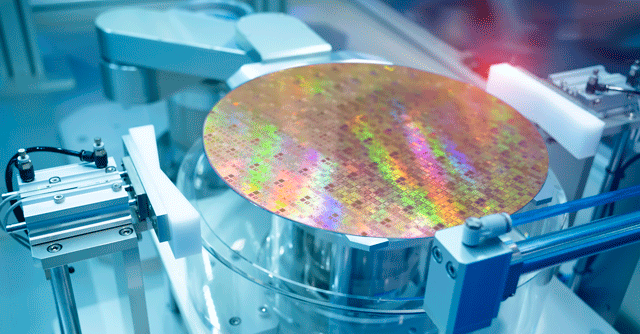
India may see trickle-down benefits of US’ CHIPS Act


The ban on American chipmakers building advanced technology facilities in China if they have received federal funding under the CHIPS Act could benefit countries such as India over the years, experts said.
The US government’s Creating Helpful Incentives to Produce Semiconductors (CHIPS) and Science Act, 2022, aims to incentivize technology companies to build semiconductor factories in the country. However, companies accepting federal funding for the same are barred from building high-tech facilities in China for the next 10 years.
Satya Gupta, chief executive and founder of Electronic Products Innovation Consortium (EPIC) Foundation, said that while in the short term the US will benefit from these policies, in the medium term, i.e., three years or more, it could benefit markets like India.

“The $50 billion plus incentives from the US may be utilized by then, and firms will look to expand globally, and India would be a good choice. By then, markets like India, too, will have evolved to a stage where these global firms will see benefit in setting up advanced semiconductor manufacturing here,” he said.
Introduced on 9 August, the new US law comes amid tensions with China. While the scheme aims to strengthen the US manufacturing base, experts believe the 10-year embargo on high-tech manufacturing in China will eventually drive firms to markets like India, Europe and Vietnam.
The US scheme offers incentives totalling $53 billion (around ₹4.2 trillion) for firms building chip factories in the US. These are more than five times India’s ₹76,000 crore (approximately $10 billion) production-linked incentive (PLI) scheme for chipmakers announced earlier this year. Among the world’s top 10 chip design and manufacturing firms, US chipmakers earned 33.2% of $59.5 billion that global semiconductor companies earned in 2021, according to an April 2022 report by market researcher Gartner. Samsung, Intel, SK Hynix, Micron, Qualcomm, Broadcom, MediaTek, Texas Instruments, Nvidia and AMD comprised the top 10. Other than Samsung, MediaTek and SK Hynix, the rest are American firms.

The White House said Micron and Qualcomm plan to build new facilities in the US. While Micron plans to spend $40 billion by 2030 to make memory chips in the US, Qualcomm will partner with GlobalFoundries for a $4.2 billion chip-manufacturing plan in the US. Intel, which initially announced a $20 billion semiconductor fab in Ohio, said in June that its plan was delayed to understand the CHIPS Act. The company now plans to begin work on its factory by end-2022, and production is expected to begin by 2025.
India currently does not have an ecosystem in place for advanced semiconductor manufacturing. However, conglomerates such as the Tata group and Vedanta have expressed interest in setting up chip operations here, and the government has also received interest from some global firms. Commerce minister Piyush Goyal met executives of American chip companies such as LAM Research and Applied Materials on 8 September to explore greater collaboration with Indian companies.
In April, Applied Materials said it plans to invest $50 million in a new research and development (R&D) facility in India, while Mint reported last month that LAM Research plans to set up its second R&D facility in India this month.

“India has already introduced a production-linked incentive (PLI) scheme to attract global clients. Alongside this, it’s not like India has no existing ecosystem of the semiconductor industry—Semi-Conductor Laboratory (SCL) in Mohali, Punjab, manufactures semiconductor chips in partnership with local and Israeli suppliers,” noted Vivek Tyagi, chairman of industry body Indian Electronics and Semiconductor Association (IESA).
Rajeev Khushu, advisor and board member of IESA, said that semiconductor supply chain vendors in India do not have the necessary quality to match the global standards required for making the latest generation chips. SCL, for instance, still makes 180nm chips at its facility. This, according to both Khushu and Tyagi, could see semiconductor fabs come up in India over the next five years as global tech firms look at markets beyond Taiwan, Korea and China to set up advanced facilities.
“India has already seen some interest from vendors to set up assembly, testing, marking and packaging (ATMP) facilities in the country based on the semiconductor PLI scheme, which could precede the establishment of chip factories since the latter would take larger sums of investment,” Khushu said.

Navkendar Singh, associate vice-president at market research firm International Data Corp (IDC) India, said, “What China has succeeded in doing has been to bring down the pricing of chips, thanks to vastly available and affordable skilled labour and the overall scale of manufacturing. This could be a factor that semiconductor firms struggle to meet in the immediate future.”
Singh said that moving the manufacturing of chips away to other markets (including India and the US) could see companies incur a higher cost of manufacturing.
“It is also unlikely that any company will ever put all their eggs in one basket again, so India will likely not be the sole beneficiary of the US‘ new law. The overall impact could see India make gains in the semiconductor space in the long run, but it will most likely not be the only nation taking advantage of the diversification of the semiconductor supply chain,” Singh added.

